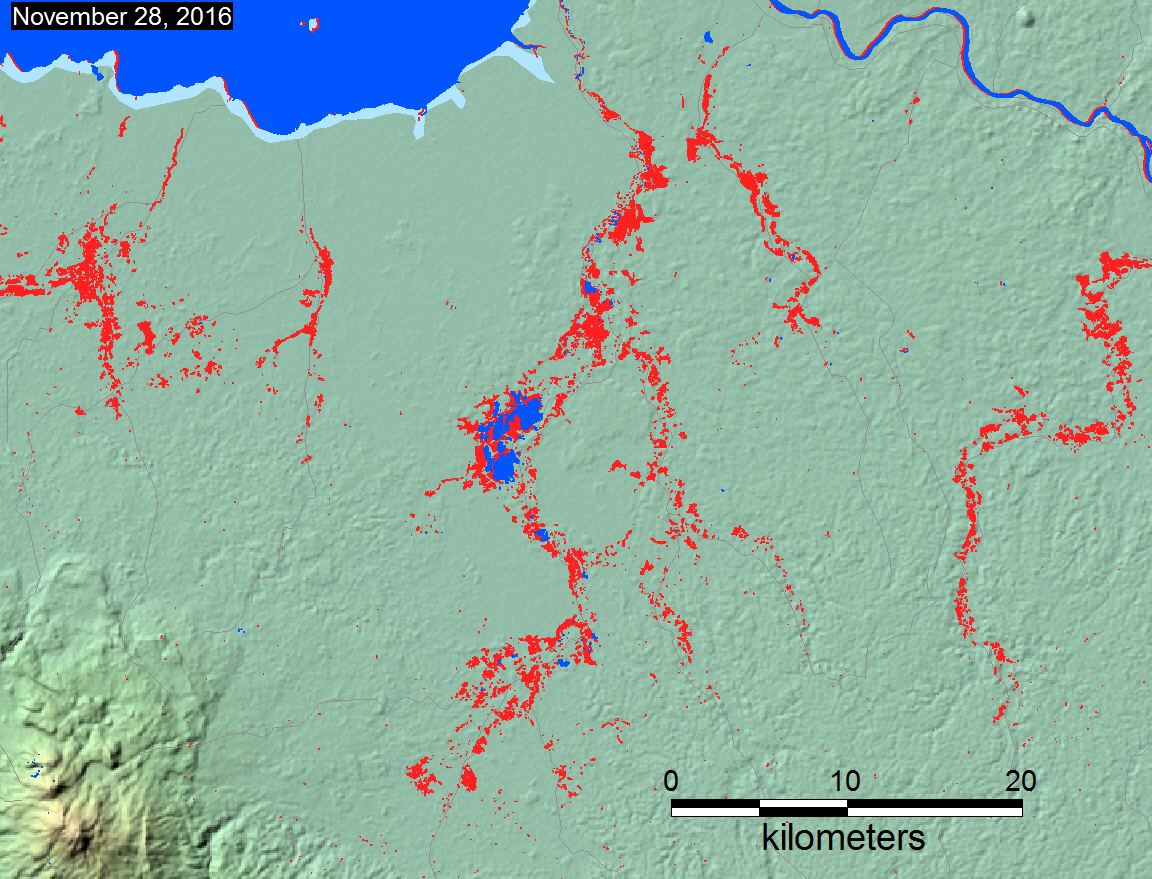


DFO Flood Event 4418
Costa Rica Flooding, November 28, 2016
Flood Map (Costa Rica)
Red color is flood water mapped from ESA Sentinel 1 SAR data.Dark blue is permanent surface water mapped from Landsat 8 image data prior to the flooding.

Geotif version
Google Earth kmz version
Explanation
Event Reporting:
The Flood Observatory maintains a Global Active Archive of large flood events, 1985 to present. It is available to the public in both spreadsheet and GIS formats (both formats together provide the complete Archive). New events are entered into this archive each week. As of the end of 2015, there were 4319 events; each has a unique archive number.
Event Mapping:
In some cases, severe or damaging floods become the focus of Observatory inundation mapping. As part of collaborations with other organizations, and the Global Flood Partnership, the Observatory's maps and other data are made available to the public. With attribution, they can be used freely, including for commercial purposes, under the terms of the Creative Commons Attribution 3.0 Unported License. Geotif versions and GIS files are also provided for these maps through the links below. This event is selected for Observatory production of map and GIS data products.This web page and associated image and map (GIS) files are the permanent Flood Observatory record of this event.
This Event:
This Flood List link provides a summary. According to Flood List: "Over the last week Hurricane Otto storm has affected parts of Panama, Nicaragua and Costa Rica, causing at least 13 deaths and forcing thousands from their homes. Otto is the southernmost hurricane to hit Central America and one of the few to crossover from the Atlantic Ocean to the Pacific Ocean. Otto made landfall as a Category 2 hurricane on the Caribbean coasts of northern Costa Rica and southern Nicaragua in the afternoon of 24 November 2016, causing significant damage. Nine people have died as a result of the storm in Costa Rica and at least 4 in Panama. Hurricane Otto formed as a Tropical Depression on Monday 21 November 2016 east of San Andrés Islands in the Caribbean Sea. After causing serious damage in Panama, Otto reached the coasts of Nicaragua and Costa Rica with sustained winds up to 175 km/h, making landfall near the city of San Juan de Nicaragua. Otto left at least 4 people dead in Panama, with some reports claiming the death toll to be as high as 8. According to the National Hurricane Center (NHC), Hurricane Otto is the southernmost hurricane to hit Central America. Otto was the first tropical cyclone to cross through Costa Rica since records began in 1851. The storm dropped an impressive amount of rain in the northern provinces of Costa Rica. According to the National Weather Institute of Costa Rica (Istituto Meteorológico Nacional, IMN) rain up to 120 mm in 3 hours was recorded on the 24 November 2016 in several stations in Guanacaste and Alajuela "
Suggested citation:
Brakenridge, G.R.., date accessed, "DFO Flood Event 4418", Dartmouth Flood Observatory, University of Colorado, Boulder, Colorado, USA, http://floodobservatory.colorado.edu/Events/2016CostaRica4418/2016CostaRica4418.html
Image Data Sources:
NASA Landsat 8 and ESA Sentinel 1data used in this map were obtained from the the U.S. Geological Survey Hazards Data Distribution System. Landsat 8 is jointly managed by NASA and the United States Geological Survey. Also see International Charter Space and Natural Disasters Activation.
GIS Data Sources:
GIS files supporting this Flood Event Map are located in a map sheet folder here.
Click here for access to the automated daily MODIS-derived .shp file GIS record (record commences in 2011). Choose appropriate 10 deg x 10 deg map sheet directory and appropriate dates; longitude and latitudes refer to upper left map sheet corner.
Related Data:
Global Flood Monitoring System (GFMS) displays, if provided, are from the University of Maryland. Reference: Wu, H., R. F. Adler, Y. Tian, G. J. Huffman, H. Li, and J. Wang (2014), Real-time global flood estimation using satellite-based precipitation and a coupled land surface and routing model, Water Resour. Res., 50, doi:10.1002/2013WR014710. Global Flood Awareness System (GloFAS) displays, if provided, are from the European Commission Joint Research Centre and the European Centre for Medium-Range Weather Forecasts. Reference: Alfieri, L., Burek, P., Dutra, E., Krzeminski, B., Muraro, D., Thielen, J., and Pappenberger, F.: GloFAS – global ensemble streamflow forecasting and flood early warning, Hydrol. Earth Syst. Sci., 17, 1161-1175, doi:10.5194/hess-17-1161-2013, 2013.
Support provided by:
The Disasters Program of NASA Applied Sciences to the University of Colorado. GPM and AMSR-2 satellite microwave data for River Watch specially processed first within GDACS at the Joint Research Center of the European Commission. DFO participates in the Global Flood Partnership.

(counting since December 2,, 2016)






